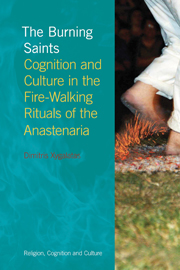Book contents
- Frontmatter
- Dedication
- Contents
- List of illustrations
- Acknowledgements
- 1 Introduction
- 2 Tradition in the making
- 3 The ethnographic setting
- 4 Fire-walking in Agia Eleni
- 5 Knowledge and revelation among the Anastenaria
- 6 Ritual and mind
- 7 Costly rituals
- 8 Arousal, emotion and motivation
- 9 The physiology of high-arousal rituals
- 10 Putting it all together
- Notes
- Bibliography
- Index
3 - The ethnographic setting
- Frontmatter
- Dedication
- Contents
- List of illustrations
- Acknowledgements
- 1 Introduction
- 2 Tradition in the making
- 3 The ethnographic setting
- 4 Fire-walking in Agia Eleni
- 5 Knowledge and revelation among the Anastenaria
- 6 Ritual and mind
- 7 Costly rituals
- 8 Arousal, emotion and motivation
- 9 The physiology of high-arousal rituals
- 10 Putting it all together
- Notes
- Bibliography
- Index
Summary
As we have seen, the fire-walking rituals of the Anastenaria were brought to Greece by refugees who were displaced from their homeland in Eastern Rumelia and relocated in Northern Greece after the division of the former dominions of the Ottoman Empire among the Balkan states. Almost a century later, these rituals were still performed in the same five villages in Greek Macedonia, defying radical transformations that have come about in virtually every sector of life. In order to situate the reader into the overall setting of the performance of the Anastenaria, I will attempt in this chapter to provide a brief overview of certain aspects of life in rural Greek Macedonia, and in particular in the village of Agia Eleni, where my ethnography was conducted. This overview will necessarily be compendious and selective, as it is not my goal here to provide a broad account of Greek culture, but instead to point to certain of its features that may be relevant to the general context in which the Anastenaria operate.
Cultural crossroads
Greece lies at the furthermost Southeastern corner of Europe, at the tip of the Balkan peninsula, neighbouring with Asia to the East and Africa to the South. It is surrounded by the Aegean Sea to the East, the Libyan Sea to the South and the Ionian Sea to the West, and it borders by land with Albania, the Former Yugoslav Republic of Macedonia and Bulgaria to the North and with Turkey to the East.
Information
- Type
- Chapter
- Information
- The Burning SaintsCognition and Culture in the Fire-Walking Rituals of the Anastenaria, pp. 35 - 60Publisher: Acumen PublishingPrint publication year: 2012
